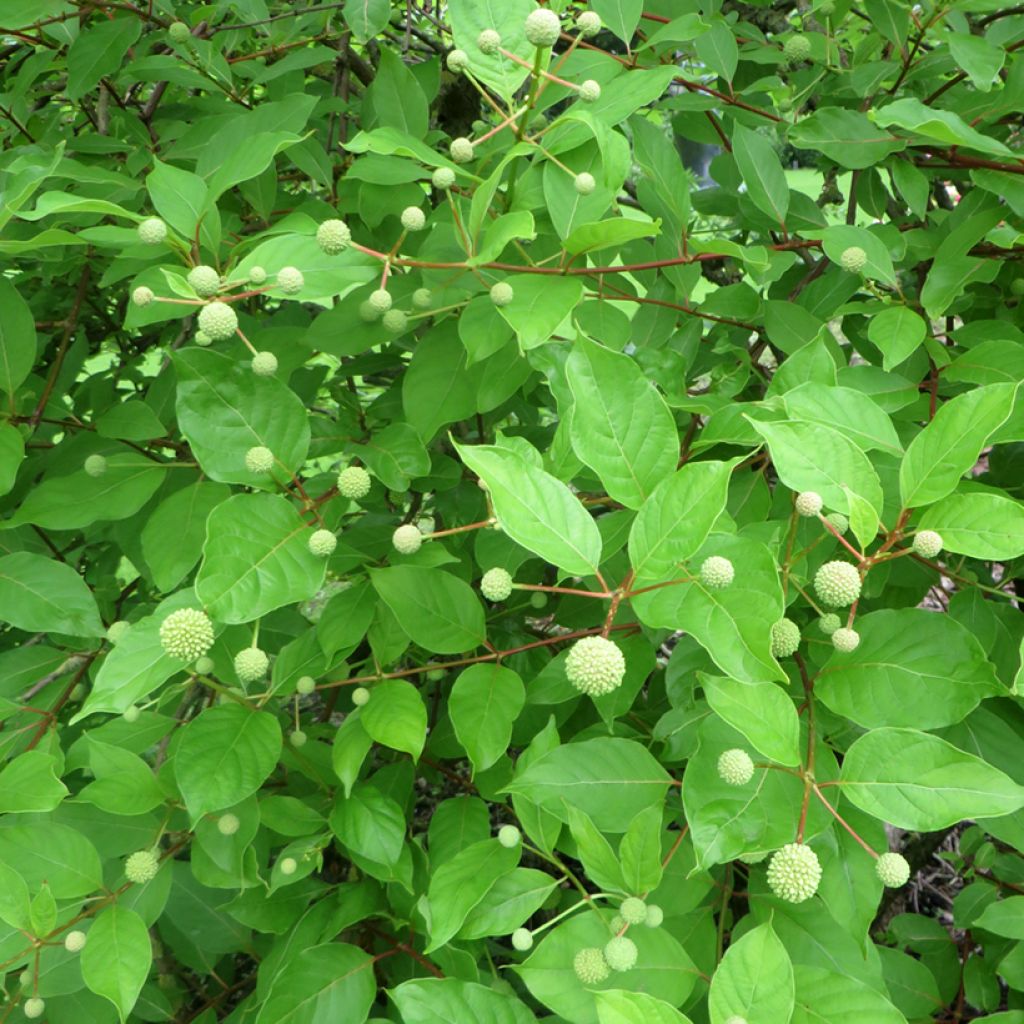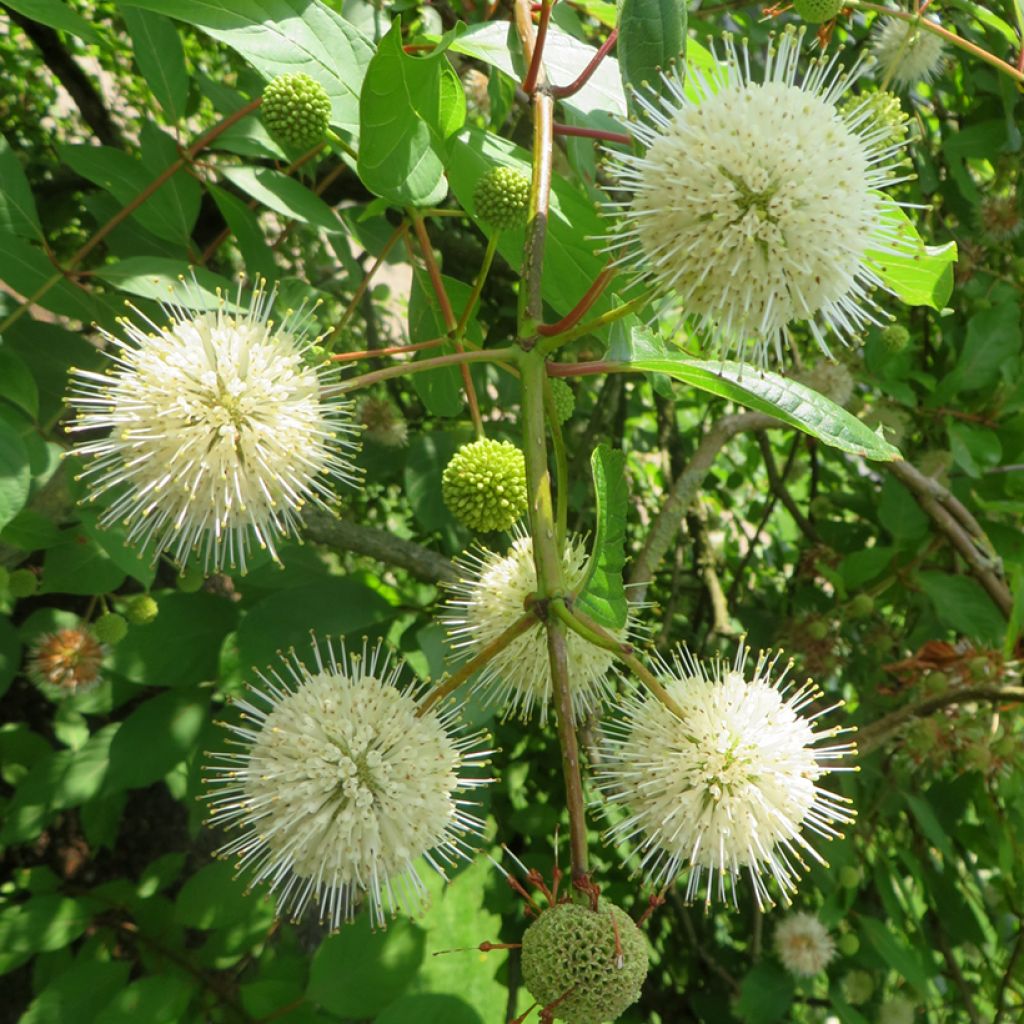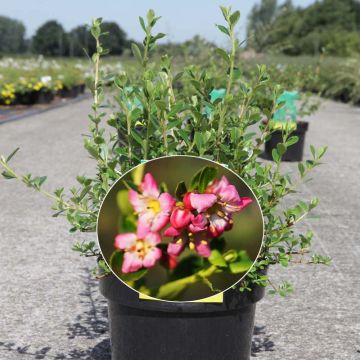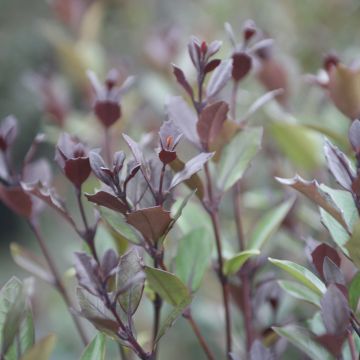

Cephalanthus occidentalis Moonlight Fantasy


Cephalanthus occidentalis Moonlight Fantasy
Cephalanthus occidentalis Moonlight Fantasy
Cephalanthus occidentalis Moonlight Fantasy
Buttonbush, Button-willow, Honey-balls
This item cannot be shipped to the selected country
Delivery charge from €5.90
More information
Schedule delivery date,
and select date in basket
This plant carries a 24 months recovery warranty
More information
We guarantee the quality of our plants for a full growing cycle, and will replace at our expense any plant that fails to recover under normal climatic and planting conditions.
From €5.90 for pickup delivery and €6.90 for home delivery
Express home delivery from €8.90.
Does this plant fit my garden?
Set up your Plantfit profile →
Description
The Cephalanthus occidentalis 'Moonlight Fantasy', now renamed 'Magical Moonlight', is a deciduous bush of beautiful stature, unique for its summer flowering in the form of small white, melliferous and fragrant balls. It also stands out in autumn with the very pale yellow colour of its foliage. This uncommon plant is reserved for cool to wet areas, especially for vegetating a natural bank or pond's surroundings.
Also known as Buttonbush or Blackwood, the Western Cephalanthus is native to North and Central America. It is a plant of the Rubiaceae family, like gardenias. In nature, it grows on the banks of rivers in wet and fertile soils. It is a deciduous species highly resistant to cold (-20 °C) that loses its foliage in late autumn.
The Cephalanthus 'Moonlight Fantasy' is a cultivar selected in Ohio for its more compact habit, its very white flowers, and its very pale autumn foliage. It is a bushy and rounded bush, wider than tall, quickly reaching 1.65 m in height and 2 m in width, on average. The leaves appear relatively late in spring. They are 10 cm long, ovate, lanceolate, shiny, of a bright green, arranged oppositely on gray-brown branches. In October, they turn very pale yellow. This bush blooms at the end of the branches between July and September, depending on the climate. Its globular inflorescences, 3 cm in diameter, are composed of multiple tubular flowers with a prominent pistil. They exhale a sweet honey scent. It is a nectariferous and melliferous flowering.
The 'Moonlight' Cephalanthus will be useful for stabilising the bank of a natural pond while bringing a touch of originality. It will thrive in marshy terrain or pond edges associated with Japanese irises, astilbes, or filipendulas. To accompany it, choose other shrubs for moist soil, such as the Dwarf Willow Salix purpurea 'Nana' or the Sorbaria 'Pink Hopi'.
Report an error about the product description
Cephalanthus occidentalis Moonlight Fantasy in pictures


Plant habit
Flowering
Foliage
Botanical data
Cephalanthus
occidentalis
Moonlight Fantasy
Rubiaceae
Buttonbush, Button-willow, Honey-balls
Cephalanthus occidentalis 'Magical Moonlight'
North America
Other Cephalanthus - Button Bush
Planting and care
The Cephalanthus occidentalis 'Magical Moonlight' should be planted in autumn in moist soil in a sunny and warm location. This bush doesn't like limestone too much. Maintain a spacing of 1.20 m between each plant. Adding compost and coarse sand during planting is recommended to lighten a very clayey soil. Water abundantly and mulch the soil to retain moisture.
Planting period
Intended location
Care
This item has not been reviewed yet - be the first to leave a review about it.
Hedge shrubs
Haven't found what you were looking for?
Hardiness is the lowest winter temperature a plant can endure without suffering serious damage or even dying. However, hardiness is affected by location (a sheltered area, such as a patio), protection (winter cover) and soil type (hardiness is improved by well-drained soil).

Photo Sharing Terms & Conditions
In order to encourage gardeners to interact and share their experiences, Promesse de fleurs offers various media enabling content to be uploaded onto its Site - in particular via the ‘Photo sharing’ module.
The User agrees to refrain from:
- Posting any content that is illegal, prejudicial, insulting, racist, inciteful to hatred, revisionist, contrary to public decency, that infringes on privacy or on the privacy rights of third parties, in particular the publicity rights of persons and goods, intellectual property rights, or the right to privacy.
- Submitting content on behalf of a third party;
- Impersonate the identity of a third party and/or publish any personal information about a third party;
In general, the User undertakes to refrain from any unethical behaviour.
All Content (in particular text, comments, files, images, photos, videos, creative works, etc.), which may be subject to property or intellectual property rights, image or other private rights, shall remain the property of the User, subject to the limited rights granted by the terms of the licence granted by Promesse de fleurs as stated below. Users are at liberty to publish or not to publish such Content on the Site, notably via the ‘Photo Sharing’ facility, and accept that this Content shall be made public and freely accessible, notably on the Internet.
Users further acknowledge, undertake to have ,and guarantee that they hold all necessary rights and permissions to publish such material on the Site, in particular with regard to the legislation in force pertaining to any privacy, property, intellectual property, image, or contractual rights, or rights of any other nature. By publishing such Content on the Site, Users acknowledge accepting full liability as publishers of the Content within the meaning of the law, and grant Promesse de fleurs, free of charge, an inclusive, worldwide licence for the said Content for the entire duration of its publication, including all reproduction, representation, up/downloading, displaying, performing, transmission, and storage rights.
Users also grant permission for their name to be linked to the Content and accept that this link may not always be made available.
By engaging in posting material, Users consent to their Content becoming automatically accessible on the Internet, in particular on other sites and/or blogs and/or web pages of the Promesse de fleurs site, including in particular social pages and the Promesse de fleurs catalogue.
Users may secure the removal of entrusted content free of charge by issuing a simple request via our contact form.
The flowering period indicated on our website applies to countries and regions located in USDA zone 8 (France, the United Kingdom, Ireland, the Netherlands, etc.)
It will vary according to where you live:
- In zones 9 to 10 (Italy, Spain, Greece, etc.), flowering will occur about 2 to 4 weeks earlier.
- In zones 6 to 7 (Germany, Poland, Slovenia, and lower mountainous regions), flowering will be delayed by 2 to 3 weeks.
- In zone 5 (Central Europe, Scandinavia), blooming will be delayed by 3 to 5 weeks.
In temperate climates, pruning of spring-flowering shrubs (forsythia, spireas, etc.) should be done just after flowering.
Pruning of summer-flowering shrubs (Indian Lilac, Perovskia, etc.) can be done in winter or spring.
In cold regions as well as with frost-sensitive plants, avoid pruning too early when severe frosts may still occur.
The planting period indicated on our website applies to countries and regions located in USDA zone 8 (France, United Kingdom, Ireland, Netherlands).
It will vary according to where you live:
- In Mediterranean zones (Marseille, Madrid, Milan, etc.), autumn and winter are the best planting periods.
- In continental zones (Strasbourg, Munich, Vienna, etc.), delay planting by 2 to 3 weeks in spring and bring it forward by 2 to 4 weeks in autumn.
- In mountainous regions (the Alps, Pyrenees, Carpathians, etc.), it is best to plant in late spring (May-June) or late summer (August-September).
The harvesting period indicated on our website applies to countries and regions in USDA zone 8 (France, England, Ireland, the Netherlands).
In colder areas (Scandinavia, Poland, Austria...) fruit and vegetable harvests are likely to be delayed by 3-4 weeks.
In warmer areas (Italy, Spain, Greece, etc.), harvesting will probably take place earlier, depending on weather conditions.
The sowing periods indicated on our website apply to countries and regions within USDA Zone 8 (France, UK, Ireland, Netherlands).
In colder areas (Scandinavia, Poland, Austria...), delay any outdoor sowing by 3-4 weeks, or sow under glass.
In warmer climes (Italy, Spain, Greece, etc.), bring outdoor sowing forward by a few weeks.
















































